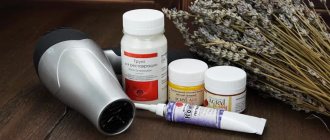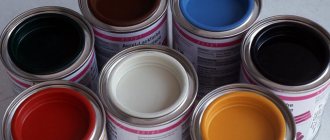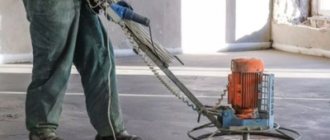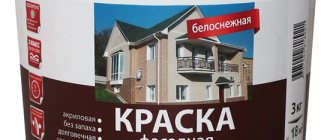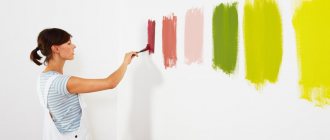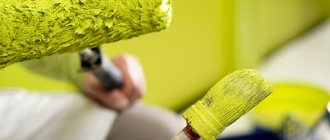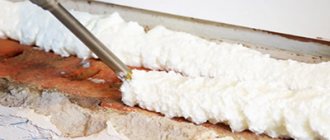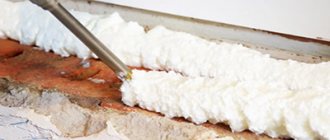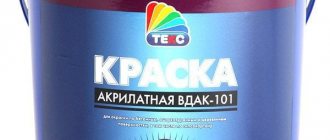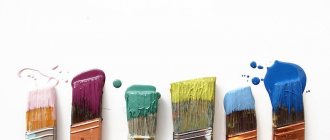Acrylic paints are based on an acrylic binder; they are made with varying degrees of matte, hiding power, and light resistance. They are tinted with a huge number of dyes, so they are used everywhere, from children's drawings to painting walls, ceilings, and concrete floors in construction. Artists and decorators value acrylic compositions because they dry quickly, much faster than oil paints. And after drying, acrylic forms an elastic film that does not crack or wash off with water.
Features of acrylic composition
The main components of acrylic paints are water, pigments and a binder, which is called an acrylic polymer emulsion or dispersion. The latter components appeared due to the ability to break down acrylic acid. Scientists have found a substance that became the basis of a new polymer - acrylic resins.
Since acrylic mixtures are multiphase, they always contain several esters that affect the properties of the product. But the produced polymer has become a unique paint base, since it itself has excellent technical qualities. Indeed, as a result, the substance turned out to be transparent and very durable. In addition, it has no pungent odors and is resistant to temperature changes. And it is not afraid of ultraviolet radiation.
Painting with acrylic paints Source livemaster.ru
The widest variety of spectrum Source digital.feirafutureprint.com.br
An excellent feature of the new component is that it combines harmoniously with water. That is, in order to bring the coloring composition into combat readiness, the acrylic binder is diluted with clean moisture and the necessary pigment is added. You also need to add a few fillers, which will be responsible for the viscosity and matting of the paint. Some of them will determine how long the acrylic paint takes to dry.
As a result, the resulting material, when applied to the surface, forms a strong film that reliably protects the pigment from environmental aggression. And allows it to remain bright and clear for many years. And the composition itself fits perfectly on almost any material and has good adhesion.
Painting a car with acrylic paint Source mensdrive.ru
Green acrylic paint Source kraski-net.ru
Pigments introduced into the acrylic base can be:
- inorganic origin;
- from organic substances;
- artificially created;
- natural.
The best and therefore most expensive is organic. The paint comes out very bright with it. But, unfortunately, it quickly loses its properties. Synthetics are used less frequently. Mainly for tinting and paste. More often they focus on natural ingredients. Such as iron, lead, chromium.
For example, white paint is made using titanium dioxin and has one feature. In order for the applied composition to fit tightly to the surface and have the most impressive appearance, components are needed that ensure adhesion and a high refractive index of light rays. And for this there must be no film that will simply reflect the light back.
White water-dispersion paint Source kraski-net.ru
Therefore, a special polymer is introduced into white acrylic paint, which prevents the formation of a reflective layer. When drying, the paint is filled with air bubbles in which the sun's rays are scattered. Therefore, the coating takes on an ideal appearance. And acrylic resins help the composition to tightly connect to the surface and retain its properties for as long as possible.
The main advantages of acrylic paints
Acrylic compositions are widely used; they are used both during interior decoration and for decorating various surfaces. The main advantage of paints is that they can be applied to almost any type of surface. In addition, they are very easy to use; you don’t have to be a professional to paint a room with high quality; thanks to their structure, even a beginner can cope with this task.
These paints are very often used when creating works related to hobbies (painting on ceramics, glass, etc.). You can paint stained glass windows or stone with paint.
They have the following advantages:
- they can be used on different surfaces;
- huge range of colors, tinting available;
- hardens and dries very quickly;
- do not have a strong odor;
- high adhesion rate (adhesion, adhesion to the surface);
- They are quite resistant to the environment, and therefore they can be used even in rooms where air humidity is high;
- you can create smooth and textured coatings;
- they are very durable and retain their color and shine for a long time;
- fresh stains can be easily and quickly cleaned off;
- can be combined with other paints;
- high-quality hiding power, allows you to save material consumption;
- can be used for both exterior and interior decoration;
- they are very easy to apply;
- resistant to abrasion, ultraviolet radiation, and various solvents;
- have low toxicity;
- are resistant to various temperature changes.
Advantages of acrylic paint
Since one of the main components of the finished composition is water, it has another feature that can answer the question of how long acrylic paint takes to dry. Some manufacturers answer - until all the moisture evaporates. After all, it maintains the required viscosity in the mixture for ease of use.
Therefore, in the superimposed layer, after removing all the water, only a heavy-duty polymer emulsion, painted over with pigment, remains. And it is for this reason that acrylic paints are more durable than oil paints, which flake and crack after several years. And also, due to the loss of all viscosity, the composition sticks tightly to the surface and no solvent will take it. And to remove it you only have to scrape it off.
Dilution of acrylic paint with a special composition Source fasad-exp.ru
Preparing acrylic paint for work Source kraski-net.ru
The main advantages of acrylic are as follows:
- Low consumption due to dilution with water without loss of texture properties.
- No deformation or shape. For this reason, all strokes fall on the surface easily and evenly.
- Many compositions dry so quickly that they even slow it down with special fillers (in painting).
- The applied mixture does not need to be fixed. That is, there is absolutely no need to open the paint with varnish or other compounds.
- Unlike oil and watercolor palettes, acrylic compositions are not afraid of ultraviolet radiation and stand in sunlight for many years.
- Due to the fact that the paint has a wide range of applications, it is produced for sale in different volumes. From small tubes to several kilogram cans.
Another advantage is the ability of acrylic paint to imitate the texture of watercolor and oil palettes. A special composition is sold for the first type. And to imitate the second, it is enough to apply a thick layer of paint.
Acrylic resins in their pure form Source obmenvsem.org
Variety of palettes
Acrylic is known for not being able to dissolve once completely dry. None of the known materials helps in resolving the issue. Therefore, you should not use the composition in conjunction with porous structures on which any other paint adheres well. Wood, even with a good varnish coating, will also be a bad choice. Glass doesn't work either.
Don't forget about additional recommendations:
- The surface must be clean and free of grease before being treated with acrylic paints. This applies even to completely new products and materials.
- Acrylic paints generally penetrate well into any type of structure. This means that it is better to pre-coat the surface with a primer. Then the result will be noticeably better.
- One of the main advantages of acrylic paints is the ability to choose absolutely any color; the available palette is truly rich. The main thing is to remember the ability of open air to increase drying time. This is especially important for those doing mixing or if glass is used.
Paints that have been thinned before starting work take longer to dry. At the same time, there is still no universal parameter; you must carefully study the instructions every time. It helps to study the accompanying documentation, which should also be attached to the compositions. It doesn’t matter what kind of packaging is used in a particular case.
More about acrylic paints (2 videos)
Acrylic-based wall paint (25 photos)
Flaws
Many buyers are confused about the names of the paint and may use it in the wrong place. Most often this happens when an interior or decorative type of palette is used on the street, instead of a façade one. But only the latter is capable of withstanding sub-zero temperatures. While the first two are intended only for internal use.
But although facade paint can withstand the negative effects of heat, cold, rain, snow and wind, experts recommend additionally opening the coating with varnish. Or other transparent fixatives. They will significantly extend the service life of the main composition.
Super-resistant acrylic paint for exterior use Source fejerverk-krasok.ru
Acrylic paint for interior work Source fejerverk-krasok.ru
The next two minuses are from the category of those that tend to go from positive to negative. For example, the fast drying time of acrylic paint turns into a real disaster for some. People do not have time to complete the work and this affects the final quality.
True, only those who deal with acrylic paint for the first time face such a problem. Well, or those who like to do any work slowly and deliberately. In this case, special additives are provided that significantly slow down the drying of the composition. And they are offered to buy along with the base.
Brushes often suffer due to this problem. If they are not put in order immediately after work (washed thoroughly), they quickly dry out. After this, the tool becomes completely unusable and all that remains is to throw it away. The same disadvantage applies to paint removal.
Brushes washed from paint Source inhomeplans.com
Types and features of paints
On the market among construction products you can find no more than four groups of paints:
- Oil and alkyd.
- Water-soluble, water-emulsion, water-dispersed.
- Specialty products regardless of the basis.
- For decorative coating.
Paints that dissolve with water can be used for external and internal work and can be used to treat concrete, brick, and plaster surfaces. Their advantage is environmental friendliness, because they do not contain organic solvents, and such a surface will allow air to pass through, since a vapor-proof film will not form. This group of paints is produced on the basis of polyvinyl acetate, styrene butadiene and acrylic dispersions.
Oil dyes are also used indoors and outdoors; they paint and protect wood and metal. They form a strong vapor-proof film on the painted material, that is, it is fire and toxic.
There are four types of paints in total
Special coloring agents have been developed to protect wood from fungi and mold and those that impart water-repellent properties to the surface.
The decorative group serves to hide errors or small irregularities in the building material being painted.
Which paint dries faster?
We always use paint when we repair or re-build something, because we cannot do without painting surfaces. Almost all dyes have a characteristic, pronounced odor. And we all want to get rid of it as soon as possible. And to achieve the desired result, you need to dry the paint quickly. If the paint is oil-based, you will have to work hard to make it dry quickly. The best way is to replace it with water-soluble or alkyd. It dries quickly and will not cause any inconvenience when using it. Well, if this option is not suitable, you should find out all the ways to dry the paint.
Examples of using
Acrylic is used everywhere. It adheres well to any surface, with the exception of a few types of plastic. Moreover, the composition is applied to the plane in various ways. From brush and roller to spray can and spray.
The composition can be used in any living space, even a children's room. Since dried paint is not afraid of water, it is excellent for bathrooms and bathrooms. An interior or decorative look is chosen for these purposes.
Painting walls using a roller Source brilias.com
Paint the door with acrylic spray paint Source kraski-net.ru
But the façade palette is also widely used. It helps protect concrete and metal structures outdoors from the elements. This is especially important if there are parts that are susceptible to corrosion. The use of the composition on wood protects it from pests and moisture.
If the house has floors with a concrete or wooden surface, then the composition should be applied in at least two layers. First the surface is primed and then painted. And you don't have to worry about how long it takes for floor paint to dry. In most cases, the work can be completed the next day.
Since a special wear-resistant composition is produced for the floor, the surface will last up to 10 years without repair. And the next day you can safely wash it with water. Moreover, you can paint not only in interior spaces. The mixture holds up well on outdoor areas. The truth loses its properties a little faster.
Painting curbs on the street with acrylic paint Source change.org
Another popular application is painting the bathroom. Moreover, not only the walls are often covered, but also the ceiling in the room. Moreover, the applied composition looks on the surface like a thin layer of plastic. And special components in the mixture do not allow mold to develop.
The problem with paint taking a long time to dry
Oil-based floor paint based on drying oil is rarely used nowadays, more often glossy varnishes based on alkyd-urethane resins with targeted additives and various solvents are used. This parquet varnish will easily adhere not only to wood (parquet, boards, chipboard or cork), but also to concrete or metal.
However, the drying time for the second layer of varnish (and at least 2-3 layers will be needed) will be 8-10 hours, the third layer will take at least 24 hours. The floor itself can be “put into operation” no earlier than in a few days: even a slight touch to the varnish surface before it has completely dried can damage its mirror-like smoothness.
Lacquer paint does not dry as quickly as we would like. And the smell! Not only is the smell pungent and unpleasant, it is also very harmful to health!
So that floor paint or paint for walls and ceilings does not disappoint you, and repairs remain in your memory as a troublesome but pleasant event, it is worth understanding the properties and features of the product you have chosen.
What determines the drying time?
To understand how long it takes acrylic paint to dry, you need to look at all the factors that influence this process. But since it mainly depends on the evaporation of water from the composition, first of all they pay attention to climatic conditions. You also need to consider the type of base on which the paint will lie and how thick it should be applied.
Painting wood with acrylic paint Source kraskovik.ru
Enamels and nitro paints
For most of these compositions, coating with a second layer is allowed within 20-30 minutes after applying the first layer. It takes about the same time for the second layer to dry. Manufacturers allow up to 12 hours for complete hardening so that painted products can be used.
Please note that nitro-based paints dry faster than enamels. This is also due to the primary areas of use of nitro paints and enamels. The former are mostly intended for painting metal and plastic surfaces (provided that the solvent in the paint base does not “eat” the plastic). Enamels can be used to cover any surface, including wood.
Sergey Yurievich
Construction of houses, extensions, terraces and verandas.
Ask a Question
For PF 115 enamel, for example, the drying time is directly related to the thickness of the layer applied during painting and the color of the paint. For example, it will take 48 hours for cherry and red enamel to dry. For everyone else, 24 hours is enough.
Temperature
Uninformed people have a strong belief - the hotter it is indoors or outdoors, the faster the drying processes occur. This is partly true, since already at +24°C the top layer of paint quickly turns into a crust. But underneath there remains an undried mixture.
It turns out that the applied paint is divided into two levels. The upper one has already dried, and the process of moisture evaporation continues in the lower one. True, she has nowhere to go, because there is no longer a passage. But the force of the couple is still enough to break through the dried layer and come out. In this case, cracks form on the surface, and the work is considered damaged.
A layer of acrylic paint that has burst due to improper drying Source auto.orsk.ru
Processes proceed completely differently when there is not enough heat. When the temperature drops below +10°C, the evaporation of moisture stops, and it begins to intensively crystallize. In this case, the layer may collapse, and the procedure itself will be delayed for a long time.
Therefore, the optimal temperature for intense steam release is considered to be between 18 and 20 degrees Celsius above zero.
How does the material harden?
Acrylic paint initially contains a hardener, due to which the polymerization reaction is activated when the composition is applied to the surface. The material of manufacture in this case does not matter. Ambient temperature is the main catalyst that initiates the reaction. The higher the temperature, the less time it takes to dry completely.
When performing work inside and outside, it is often possible to achieve surface heating of up to 25 degrees, or even higher. This certainly does not lead to instant drying of the material. Drying time increases. It is better to use special equipment if possible.
On video: what is acrylic paint?
Humidity
The pattern here is clear. The more moisture in the air, the more significant the surface is moistened. And this prevents internal water from leaving the paint. And until the atmosphere in the room becomes drier, the evaporation process may drag on indefinitely.
High humidity in the room Source mrrestavrator.ru
What can I do to make the composition dry longer?
Sometimes situations happen when acrylic dries very quickly and this leads to cracking.
In order to slow down the drying of the paint, you can resort to the following methods:
- it is necessary to reduce the air temperature in the room, but maintain the recommended temperature;
- increase the air humidity, this can be done with various humidifiers, or bring a bucket of water into the room and put one end of a rag in it, the main thing is not to overdo it, since the air humidity should not be higher than 75 percent;
- avoid drafts in the room so that air movement is minimized;
- add a retarder that prevents drying, retarders are mainly made on the basis of glycerin, they slow down the rate of passage of water and solvent through the paint and this increases the drying time;
- apply the paint in a thicker layer, but you should not make a layer that will be thicker than 3 mm.
Airflow speed
If all the windows and doors in a room are closed, there is no movement of air masses in it. Therefore, all fumes from the paint collect in a cloud above the surface. And this already means an increase in humidity. What happens in this case has already been described.
Creation of forced ventilation Source pixel-shot.com
It is necessary to establish good air circulation in the room. So that any moisture that comes out of the paint is immediately blown away. It should be noted that in any well-ventilated room the humidity drops significantly.
How long does oil paint take to dry?
Oil-based paints traditionally take the longest to dry. In recent years, manufacturers have abandoned the use of natural drying oil for such compositions. Now in the mass production of oil paints, alkyd or pentaphthalic bases are used. This reduced the drying time of oil paints to one day.
Complete hardening of one layer occurs only as a result of oxidation of the upper oil layer. Factors that matter here include:
- air temperature;
- humidity;
- presence of direct sunlight.
Oil paints with the addition of antiseptic compounds take longer to dry. The period of time sufficient for drying of such and similar paints is indicated to the manufacturers on the can. In any case, drying time is at least 12 hours.
Surface condition
How long the paint takes to dry always depends on what plane it is applied to. If the material is porous, then it immediately begins to take water from everything possible. This absorption, along with evaporation, speeds up the drying process significantly. Similar properties are present in wood, paper and drywall. Canvas and any fabrics draw moisture out. Plastered and puttied surfaces also have these qualities.
Applying paint to metal Source gidpokraske.ru
It's a completely different matter with smooth planes that repel water. On metal, glass and plastic, paint will take much longer to dry.
Types of varnish based on drying speed
The drying time of the varnish is one of the main characteristics. Practice shows that bringing this parameter to perfection leads to a decrease in performance in other parameters.
Related article: Technology of painting wooden stairs and selection of materials
Thus, quick-drying varnish is much more expensive than regular varnish, but it is not always environmentally friendly, and very often such a coating is not durable. The time it takes for the surface to dry is a relative parameter. One master needs a dry surface after 60 minutes, while another can wait several days to obtain a high-quality coating.
In the video: what is the best varnish to cover the walls.
Nitrovarnishes
Transparent, matting nitro varnishes are made on the basis of colloxylins. The product consists of resins, solvents and plasticizers. Materials in this group are resistant to moisture and have one of the highest drying rates. The nitro varnish dries to the touch within 30-60 minutes.
For complete drying, it should take from 3 to 5 hours. But these products cannot be classified as environmentally friendly. They contain toxic solvents. These materials should not be used in rooms where people live. Another disadvantage is the insufficient stability of surfaces.
Polyurethane
Materials of this group are widely used for flooring, parquet, and the creation of self-leveling and polymer floors. Polyurethane varnish is able to provide excellent resistance to moisture, aggressive substances, as well as mechanical stress. But how long does it take for parquet varnish to dry? Parquet varnish will dry to the first stage in just 60 minutes, and the final result will take from 4 to 12 hours. Compounds with hardener dry quickly. And still, it is impossible to say exactly how long it takes for packet varnish to dry - the process is influenced by a lot of factors.
Water based
These materials do not have any unpleasant odors, they are the safest. But it takes longer to dry. It takes 10 to 14 days for the layer to dry completely. This speed is related to the composition - water evaporates much longer than any solvent. It must be remembered that coatings treated with acrylic varnishes are poorly resistant to moisture and temperature changes. How long does it take for acrylic varnish to dry? Touch dry in 2-3 hours, and for final drying it will take 18-36 hours.
Oily
These types of paints and varnishes are produced on the basis of wood resin and linseed oil. They are diluted with organic solvents. Despite certain advantages, oil varnish is one of the worst options in terms of speed before complete drying. It will take two days or more for the oil composition to dry completely.
Alkyd
Alkyd varnish can also be diluted with organic solvents. Compositions based on alkyd resin are resistant to moisture and create a durable coating. Varnishing is carried out from a spray can - this is the best option. It takes 4 days for complete drying. But if necessary, this process can be accelerated several times - a hardener is added and the drying time will be reduced to 24 hours.
There are also faster-drying alkyd materials - these are alkyd-urethane paints and varnishes. Due to the presence of urethane alkyds in the composition, complete drying requires no more than 12 hours.
Related article: How to varnish a wooden table?
Epoxy
These coatings are used in interior and exterior work. At room temperature the surface will dry in 24 hours.
Yacht materials
Yacht varnish is a whole group of materials with different times for complete drying. So, yacht Aurlak will dry completely in 8 hours. Akidlak needs 16 hours, and yacht Polyurlak will dry in 45 minutes.
How long does acrylic composition take to dry?
If you use standard mixtures from the store, you can always find out how long the paint dries from the instructions on the can. Usually the period indicated is one day. It's rare to see two or three days. As a rule, any of the periods depends on the composition and purpose of the paint.
Guide to Using Paint Properly Source Pinterest
Here is what is indicated on the packaging of acrylic compounds:
- Primer and paint for painting – 1.5-2 hours.
- Painting mixtures, as well as contours - 24 hours.
- Modeling gel based on dispersion – up to three days.
- Paste interspersed with marble particles - from an hour to five.
True, you always need to take into account the thickness of the layer. If it is significant, then the time increases significantly. There is also a time for final hardening. For example, for the same paste it ranges from 24 to 36 hours. But more than all other compounds, pure acrylic resins dry out. It takes them from 7 to 14 days.
What should you pay attention to?
Before you begin painting work, you should pay attention to several factors:
- First of all, the expiration dates of the paint, which must be indicated on the can.
- Instructions for use and dilution must be read clearly and in understandable language.
- Before use, the paint must be stirred most thoroughly, checking to see if there are any thickened components left at the bottom.
- The surface must be cleaned, degreased and primed.
- What is difficult to check is the storage conditions. When oil paint freezes, it can separate even after thorough mixing and lose its properties. But here the calculation is only on the conscience of the seller.
How to speed up drying
To increase the rate of moisture evaporation from paint, it is necessary to create optimal conditions:
- Raise the room temperature to the maximum limit (+24°C).
- Dilute the composition instead of water only with a special drying accelerator.
- Organize forced air circulation in the room.
In addition, you can significantly speed up the process if you use a hair dryer and turn it on in hot air mode. But the method has severe limitations. For example, you should not use the device before the paint has firmly adhered to the surface. And this takes at least 20 minutes.
Drying paint with a hair dryer Source uk.aviarydecor.com
It is also extremely undesirable to bring the device nozzle closer than 30 cm from the surface. At a very short distance, the top layer of paint from the hot stream will immediately set and harden. But the bottom one will remain liquid. As the heating continues, the evaporation will break through the already created film.
The same result can occur if you dry it with a hairdryer on a smooth surface (metal, plastic) without even violating the specified safe limit. Therefore, the device can be used effectively only on porous surfaces that have already absorbed some of the moisture from the lower layer of paint.
Enameling bathtubs or liquid acrylic - which is better?
Factory enameling is the process of sintering the hot surface of a bath with a special powder, which results in a smooth, glossy coating.
It is clear that it is impossible to carry out work using such technologies at home. But to restore the surface of the bowl with your own hands does not require complex production technologies. To enamel a bathtub, you need to carefully prepare the bowl for this procedure:
- Using a grinder with a special attachment, the old layer of enamel is removed.
- Then the surface is sanded, treated with bath putty and degreased.
- Enameling is done with a brush or spray gun. Before this stage, the bath should be warmed up for better adhesion of the paint to the surface.
- The coating should be done in several layers: the final result of layering the paint should have a thickness of no more than 15 mm and no less than 5 mm.
The main advantage of the method is the ability to choose any color range. Enameling is also one of the cheapest ways to restore the surface of a bowl. This method has significantly more disadvantages:
- short service life of the enamel coating;
- loss of shine and yellowing of paint from the use of cleaning and detergent reagents (enamel care is permissible only with the use of a soap solution);
- the coating becomes hard, but also quite fragile, and this entails chips or cracks when hard objects fall;
- when the bath is filled with hot water, the metal expands, but the enamel remains motionless: this can lead to the occurrence of ruptures in the layers of the bowl’s coating;
- long drying time.
Stages of enameling a bathtub Glass coating (liquid acrylic) has clear advantages over enameling:
- absence of a sharp unpleasant odor during application;
- acrylic is flexible, plastic, susceptible to expansion when heated with hot water;
- short-term drying;
- easier method of application;
- longer service time.
The disadvantages of stacrylic coating include loss of gloss from the use of abrasive and chemical substances: just as in the case of enameling, liquid acrylic is sensitive to the effects of cleaning reagents and mechanical damage.
